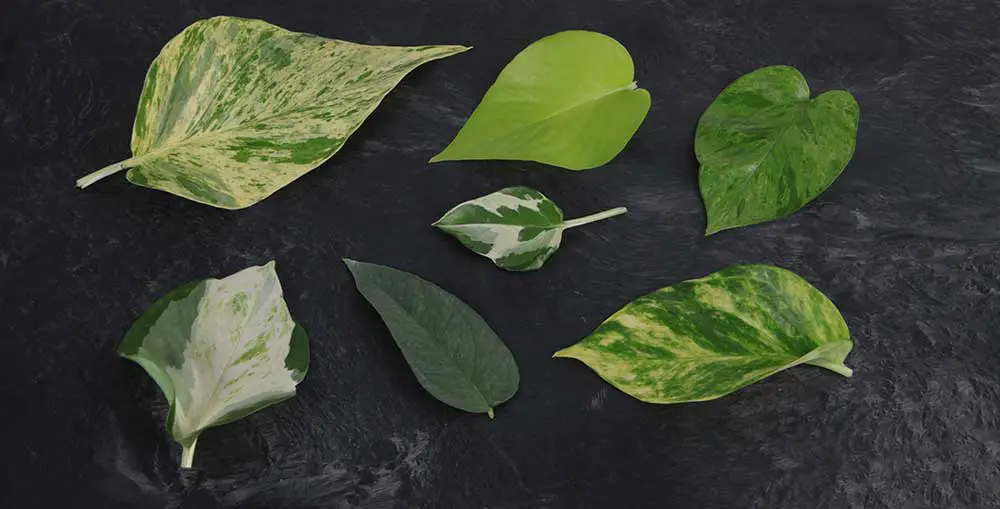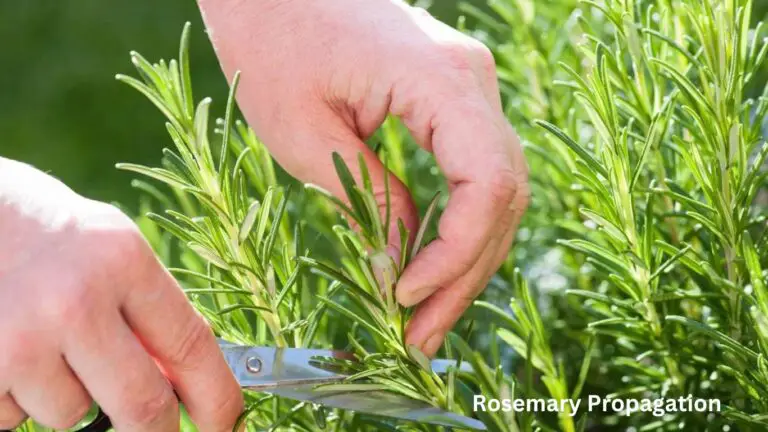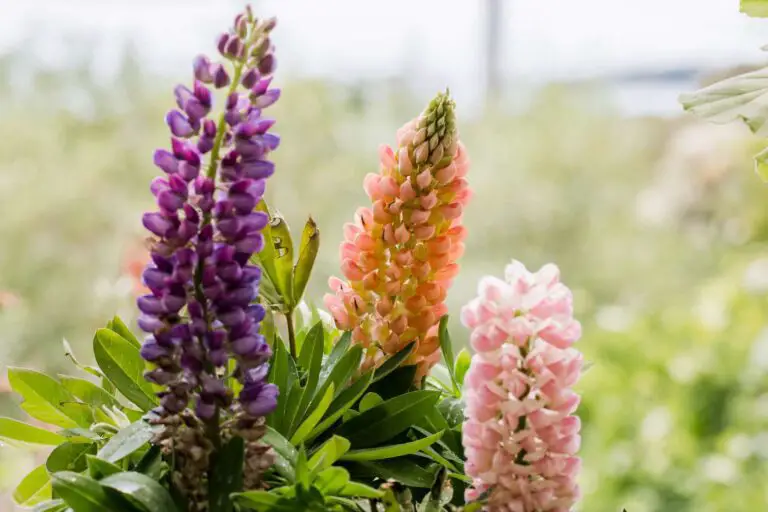Explore 12 Varieties of Pothos for a Diverse Collection
Are you ready to elevate your indoor greenery game? Pothos, known for their lush foliage and easy-care nature, offer a diverse range of varieties to explore. From the classic Golden Pothos to the striking Marble Queen, each type brings its own charm to your plant collection. In this blog, we delve into 12 captivating Pothos varieties that will add a touch of elegance and freshness to your space. Whether you’re a seasoned plant enthusiast or a newbie looking to green up your home, these Pothos options are sure to captivate your heart and enhance your indoor oasis. Get ready to transform your space with these stunning plants!
Table of Contents
Marble Queen Pothos
Intriguing and captivating, the Marble Queen Pothos is a remarkable addition to any indoor plant collection.
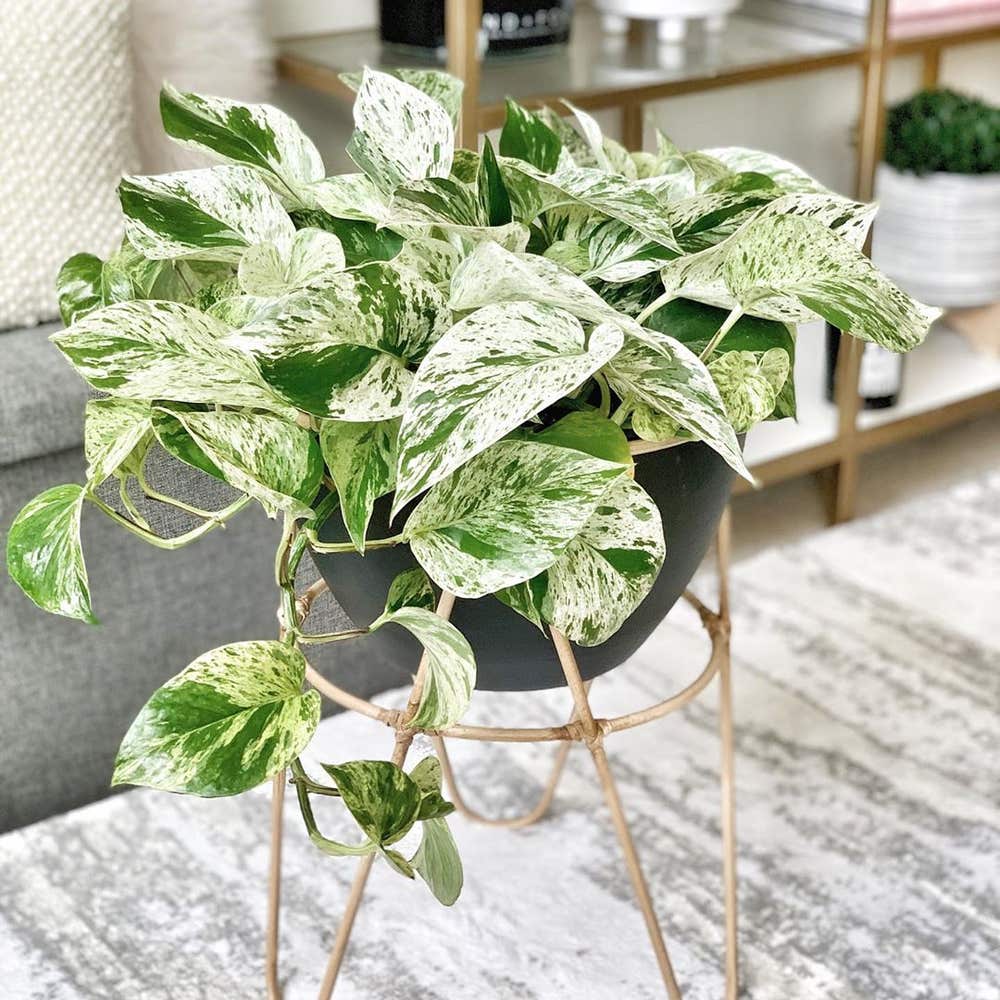
- Bright, Indirect Light: The Marble Queen Pothos thrives in bright, indirect light. Place it near a window where it receives filtered sunlight. Avoid exposing it to harsh, direct sunlight, as this can lead to leaf damage.
- Variegation Maintenance: To maintain the distinctive variegation of its leaves (the creamy white and green patterns), ensure it receives adequate light. Insufficient light may cause the variegation to fade, while too much direct sun can scorch the leaves.
- Tolerant of Lower Light Levels: While it prefers bright light, the Marble Queen Pothos can tolerate lower light conditions. If you have limited natural light, it will still grow, but its variegation may be less pronounced.
- Avoid Full Shade: Placing the Marble Queen Pothos in full shade is not recommended. It may lead to slow growth and reduced overall health. Aim for a balance between light exposure and shade.
Remember to monitor your plant’s response to its current location and adjust accordingly. Happy gardening! 🌿🌱
I recently purchased “The Ultimate Guide to Pothos Plants and Philodendron” on Amazon and I’m thrilled with my purchase. This book is a must-have for anyone interested in growing these popular and versatile houseplants. The author provides detailed information on 12 varieties of Pothos, including their care, propagation, and common problems. The book is well-organized, easy to read, and includes beautiful color photographs of each variety. I particularly appreciate the troubleshooting section, which has helped me diagnose and solve some issues I’ve had with my own Pothos plants. Overall, I highly recommend this book to anyone looking to expand their knowledge of Pothos and Philodendron plants.
- Comprehensive Information: Books often provide in-depth information about the care, propagation, and varieties of Pothos plants, allowing readers to become well-informed.
- Visual References: Many plant books include colorful images and illustrations, aiding in plant identification and showcasing different varieties.
- Detailed Guidance: Guides may offer step-by-step instructions on topics such as potting, pruning, and troubleshooting common issues, helping readers become successful plant caregivers.
- Reference Material: Books serve as valuable reference material that can be revisited whenever needed, making them useful for both beginners and experienced plant enthusiasts.
- Limited Interactivity: Unlike online resources or forums, books lack the interactivity and ability to ask questions or seek clarification in real-time.
- Upfront Cost: Purchasing a book incurs an upfront cost, which may deter some individuals who prefer free or low-cost resources available online.
- Updates and Revisions: Plant care practices and information may evolve over time, rendering older books outdated. Readers may need to supplement their knowledge with additional resources for the latest information.
- Space Requirements: Books take up physical space, which may be a consideration for those with limited storage or a preference for digital content.
Golden Pothos
Golden Pothos, also known as Epipremnum aureum, is a popular and versatile houseplant that is widely cherished for its stunning foliage. This plant features heart-shaped leaves that are variegated with shades of green and yellow, adding a touch of vibrancy to any indoor space.
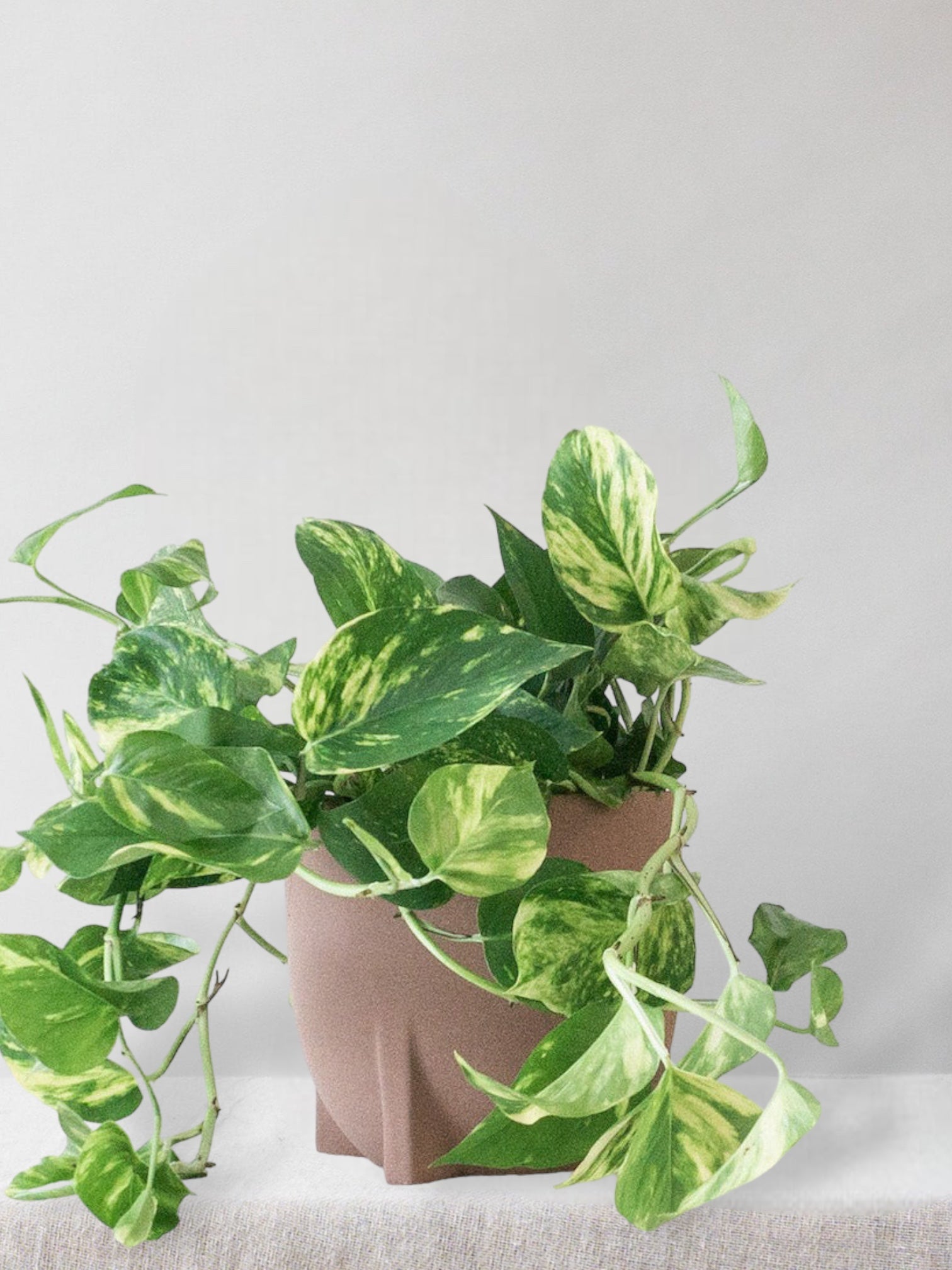
- Golden Pothos is a hardy and low-maintenance houseplant that thrives in bright, indirect light but can tolerate lower light levels.
- It can grow in various climates, making it suitable for humid to dry environments and different regions or urban environments.
- Golden Pothos prefers well-draining, light soil mix with peat moss, perlite, vermiculite, and composted bark-coconut coir.
- Overwatering can cause root rot, so it’s essential to let the soil dry out between waterings.
- Golden Pothos is generally resistant to most pests and diseases but can be affected by spider mites, mealybugs, aphids, and root rot.
- It is considered toxic for humans and animals due to the presence of insoluble calcium oxalates.
- Common problems include yellowing and brown leaves, root rot, mushy stems, and pests or diseases.
- Yellowing of the foliage may occur due to too much direct sunlight or not enough light, while brown leaves could be due to inadequate moisture or over-watering.
- Root rot occurs when roots sit in overly moist soil for extended periods without proper drainage, leading to fungal growth.
- Golden Pothos can be easily propagated in water using stem cuttings.
Using natural coconut fiber for gardening has been a game-changer in my experience. Its excellent water retention properties have significantly reduced the frequency of watering, providing a more consistent moisture level for my plants. Additionally, the coconut coir’s ability to promote soil aeration has led to healthier root systems and overall plant growth. While it may have a slightly higher initial cost, the long-term benefits, including its eco-friendly nature and biodegradability, make it a worthwhile investment for any gardener looking to enhance their growing medium.
✅ Water retention: It has excellent water retention properties, which helps to keep plants hydrated for longer periods, reducing the frequency of watering.
✅ Aeration: Coconut coir promotes good soil aeration, preventing compaction and allowing roots to breathe.
✅ pH neutral: It has a neutral pH level, making it suitable for a wide range of plants and compatible with various soil types.
✅ Biodegradable: Over time, coconut coir breaks down naturally, enriching the soil with organic matter.
✅ Low risk of pests and diseases: Coconut coir is less likely to harbor pests and diseases compared to some other growing mediums.
❌ Salinity: Some coconut coir products may contain high levels of salts, which can be harmful to sensitive plants if not properly rinsed or treated.
❌ Nutrient content: While coconut coir is a good medium for plant growth, it typically has low nutrient content. Additional fertilization may be necessary for optimal plant health.
❌ Compactness: While coconut coir promotes good aeration, it can sometimes become compacted over time, requiring occasional fluffing or amending.
❌ Sourcing: The quality of coconut coir can vary depending on the source and processing methods. It’s essential to choose a reputable supplier to ensure quality and consistency.
Neon Pothos
Neon Pothos, known for its vibrant, electric-green leaves, is a popular choice among plant enthusiasts looking to add a pop of color to their indoor spaces. This striking variety stands out with its bright foliage that truly lives up to its name. However, there are a few unique FAQs about Neon Pothos that are worth exploring.
:max_bytes(150000):strip_icc()/neon-pothos-plant-profile-5206135-hero-c6b7295fe1aa472d8e5905e85d287a5b.jpg)
- Bright, Indirect Light:
- Neon Pothos prefers bright, indirect light. Place it near a window where it receives filtered sunlight.
- Avoid direct sunlight, as it can lead to leaf damage.
- Water Propagation:
- To propagate Neon Pothos, follow these steps:
- Select a Healthy Stem: Choose a healthy stem with at least two nodes (the points where leaves attach to the stem).
- Place in Water: Put the stem in a container of water, ensuring that the nodes are submerged.
- Monitor Root Development: Over time, the stem will develop roots. Change the water regularly and observe root growth.
- Transplant into Soil: Once the roots are well-established, transplant the stem into soil for continued growth.
- To propagate Neon Pothos, follow these steps:
Remember to provide the right lighting conditions and monitor the propagation process. Happy gardening! 🌿🌱
Jade Pothos
Jade Pothos, known for its attractive foliage, is a popular choice among houseplant enthusiasts.
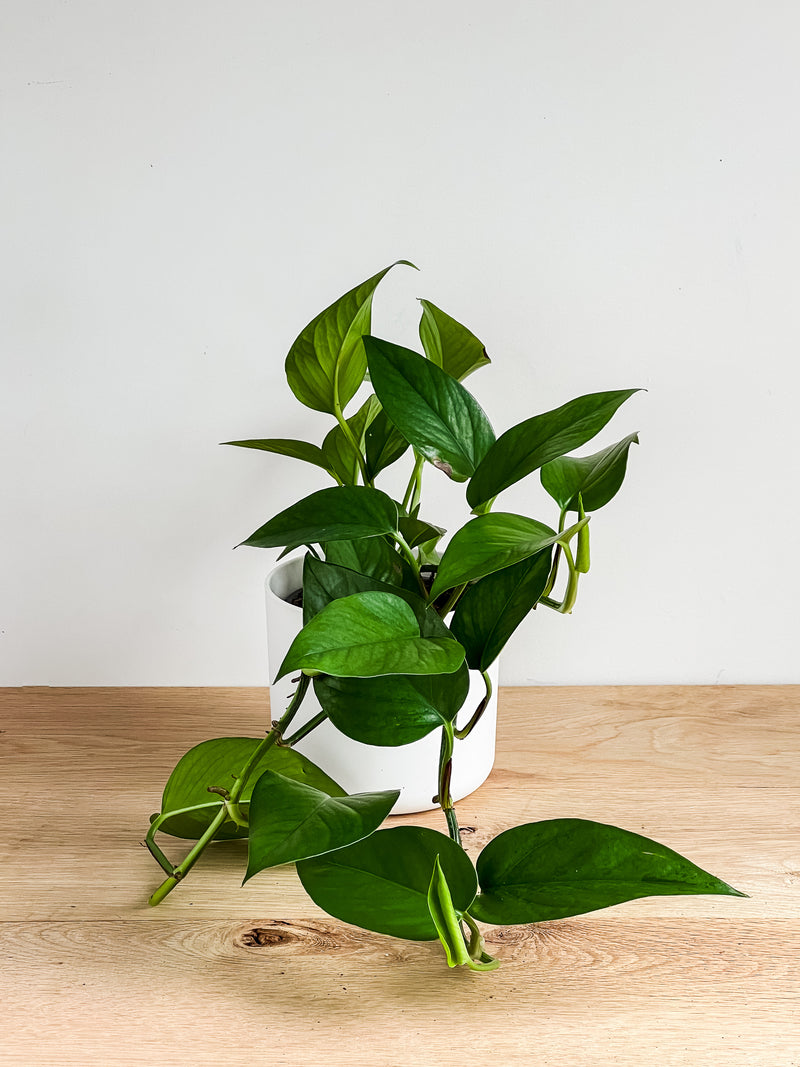
- Its heart-shaped leaves are a vibrant shade of green, with splashes of creamy yellow scattered throughout.
- While Jade Pothos shares many similarities with its close relative, Golden Pothos, it has some distinct characteristics that make it stand out in any indoor garden.
- One unique aspect of Jade Pothos is its ability to tolerate low light conditions.
- While most houseplants require bright, indirect sunlight, Jade Pothos can thrive even in dimly lit areas.
- This makes it an excellent choice for offices or rooms with minimal natural light.
- Additionally, this variety is known for its vigorous growth and trailing vines, making it perfect for hanging baskets or cascading down shelves.
Whether you are a beginner or an experienced plant parent, Jade Pothos is a versatile and beautiful addition to any plant collection.
N’Joy Pothos

- N’Joy Pothos is a cultivar of Marble Queen Pothos, known for its attractive variegated foliage with white and green splotches on both sides of the heart-shaped leaves.
- It is a vining plant that can grow up to 10 feet long, making it a great addition to any indoor garden.
- N’Joy Pothos is easy to care for and can tolerate low light levels, making it a versatile option for various indoor environments.
- It prefers bright, indirect sunlight and should be kept out of direct sunlight to prevent burning.
- N’Joy Pothos requires an airy, well-draining soil mix that retains some moisture.
- It should be watered when the top half of the soil is dry, allowing the excess water to drain from the pot’s drainage holes.
- N’Joy Pothos prefers temperatures above 65 degrees Fahrenheit (18 degrees Celsius) and enjoys humidity between 50% to 70%.
- It should be fertilized regularly during its active growing season in the spring and summer with a balanced liquid fertilizer.
- Pruning is not necessary but can be done during the spring and summer to control growth or for propagation purposes.
- N’Joy Pothos is toxic to humans and pets due to the presence of insoluble calcium oxalates.
- Common problems include yellowing and brown leaves, root rot, mushy stems, and pests or diseases.
- Yellowing of the foliage may occur due to too much direct sunlight or not enough light, while brown leaves could be due to inadequate moisture or over-watering.
- Root rot occurs when roots sit in overly moist soil for extended periods without proper drainage, leading to fungal growth.
- N’Joy Pothos can be easily propagated in water using stem cuttings.
Cebu Blue Pothos

Cebu Blue Pothos is a popular variety of pothos that stands out for its unique foliage.
- Unlike other pothos varieties, the leaves of Cebu Blue have a distinctly elongated shape, resembling a heart or a spearhead.
- This characteristic is what makes it a striking addition to any indoor space or garden.
- One unique FAQ that often arises when it comes to Cebu Blue Pothos is its preferred lighting conditions.
- While many pothos varieties thrive in low to medium light environments, Cebu Blue Pothos prefers brighter light.
- It can tolerate a few hours of direct sunlight, but it is important to avoid exposing it to intense or prolonged sunlight as it can lead to leaf burn.
- Finding the right balance of light is key to maintaining the vibrant color and growth of this exquisite plant.
Manjula Pothos

Manjula Pothos, also known as Epipremnum aureum ‘Manjula,’ is a stunning variety of pothos that is highly sought after by plant enthusiasts.
Manjula Pothos thrives in bright, indirect light.
Place it near a north-facing window or a few feet away from a south-facing window.
Avoid direct sunlight, as it can scorch the delicate foliage.
Allow the soil to dry out slightly between waterings.
Regular watering will help the plant flourish.
Remember to water it moderately, avoid direct sunlight, and enjoy the beauty of this captivating plant! 🌿
Silver Satin Pothos
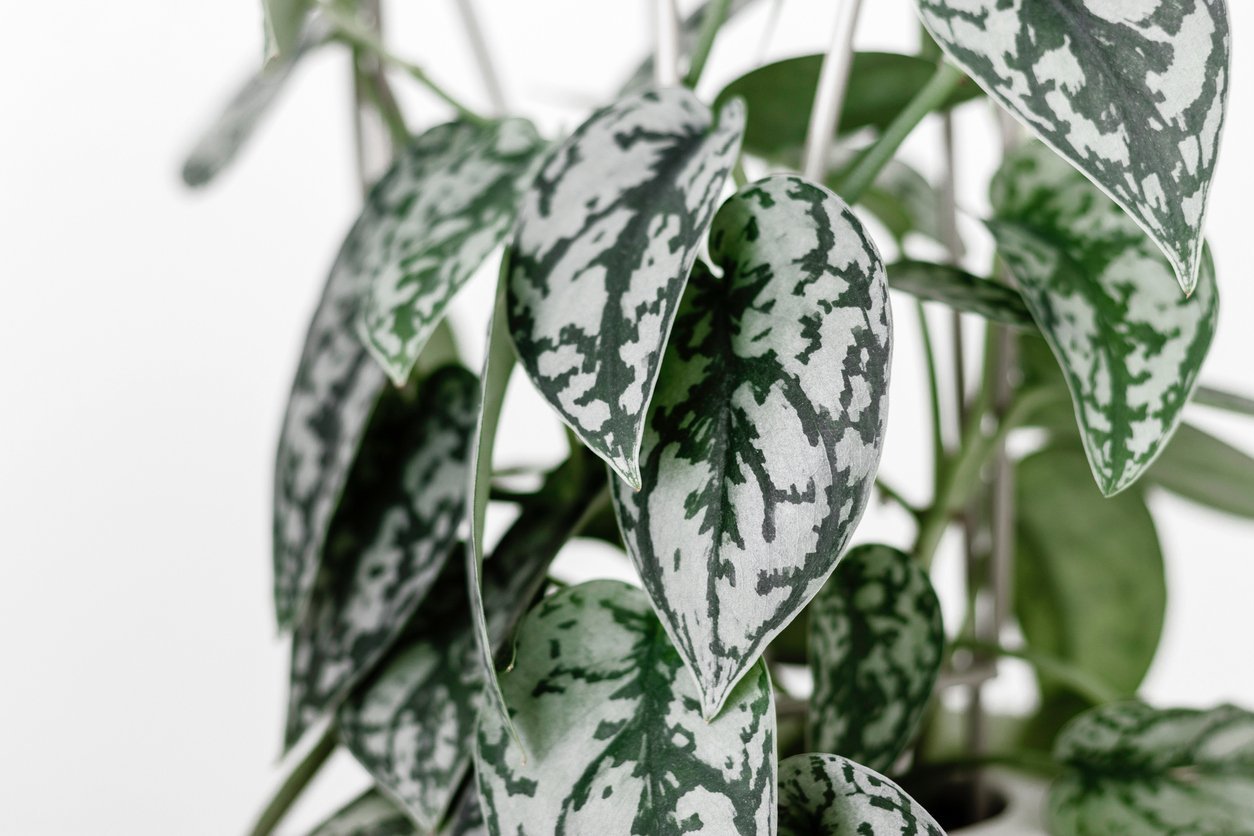
Silver Satin Pothos is a stunning variety of Pothos plant that boasts luscious, heart-shaped leaves with a beautiful silver sheen.
By following these simple care instructions, you can ensure that your Silver Satin Pothos thrives and adds a touch of elegance to your indoor oasis.
Pearls and Jade Pothos
:max_bytes(150000):strip_icc()/pearls-and-jade-pothos-hero-d37a849aff364f73af828eab8af594c6.jpg)
The Pearls and Jade Pothos is a stunning variety of the popular houseplant known for its unique foliage. With its heart-shaped leaves, which are green with white marbling, this pothos adds a touch of elegance to any indoor space. The combination of the green and white patterns on the leaves creates a beautiful contrast that is sure to catch the eye.
Jessenia Pothos
Jessenia Pothos is an exotic and eye-catching variety that adds a touch of diversity to any plant collection. With its broad, heart-shaped leaves and stunning variegation, this plant is sure to captivate the attention of plant enthusiasts. Native to the tropical forests of South America, Jessenia Pothos thrives in bright indirect light and moderate humidity. Its leaves feature a striking blend of vibrant green and creamy yellow, creating a visually appealing contrast that instantly brightens up any space.

Light and Location:
- Place the Jessenia Pothos in a location with bright, indirect light. Avoid direct sunlight to prevent leaf burn.
- Ensure the plant receives enough light to maintain its vibrant variegation and growth.
Watering:
- Water the Jessenia Pothos when the top two inches of soil feel dry to the touch.
- For plants grown in water, change the water regularly to prevent stagnation and root rot.
- Avoid overwatering, as it can lead to root rot and other issues.
Humidity and Temperature:
- Maintain moderate humidity levels between 60% to 80% for optimal growth.
- Keep the plant in a room with temperatures around 65 to 75 degrees Fahrenheit (18 to 23 degrees Celsius).
Cleaning:
- Regularly clean the leaves of the Jessenia Pothos to remove dust and maintain its health and appearance.
- Wipe the leaves with a soft, damp cloth or gently wash them with a mild soap solution.
Fertilizing and Soil:
- Fertilize the Jessenia Pothos with a balanced houseplant fertilizer according to the manufacturer’s instructions.
- Use well-draining soil with organic matter like coco coir, perlite, or vermiculite to ensure proper growth.
Repotting:
- Repot the Jessenia Pothos when roots start protruding from the drainage holes or the plant outgrows its current pot.
- Choose a pot that is at least two sizes larger than the current one and use fresh potting soil.
Pruning:
- Trim the Jessenia Pothos vines if they become too long or leggy to maintain a compact and bushy appearance.
- Prune any yellowing or damaged leaves to promote new growth.
Propagation:
- Propagate Jessenia Pothos easily by taking stem cuttings with at least two nodes and placing them in water or soil to root.
- Monitor the new growth and ensure the cuttings have adequate moisture and light for successful propagation.
In addition, providing a support system such as a trellis or moss pole can encourage upward growth and prevent the plant from becoming unruly.
Glacier Pothos
Glacier Pothos, a stunning variety of the Epipremnum aureum family, captivates plant enthusiasts with its distinct foliage. With its mesmerizing silver and blue-grey leaves, it adds a touch of elegance to any indoor space. Often regarded as a conversation starter, this cultivar offers a refreshing twist to the classic pothos plants. The Glacier Pothos is ideal for those seeking a striking plant to enhance their home decor.
:max_bytes(150000):strip_icc()/glacier-pothos-growing-guide-6504573-01-33ff44de81354b9a9d64304111b7ac8d.jpg)
- Low Light Tolerance: Glacier Pothos stands out for its ability to thrive in lower light conditions compared to other pothos varieties. While it still prefers bright, indirect light, it can adapt well to medium-low light environments.
- Drought-Tolerant: This pothos variety is more forgiving when it comes to watering. Its hardy nature makes it suitable for forgetful plant owners.
- Pet Toxicity: Unfortunately, Glacier Pothos is toxic to cats, dogs, and other household pets if ingested. Keep it out of their reach to ensure their safety. If you suspect your pet has consumed any part of the plant, consult a veterinarian promptly. 🌱🐾
Silver Splash Pothos
Silver Splash Pothos, with its striking variegated foliage, is a popular choice among plant enthusiasts looking to add a touch of elegance to their indoor spaces.
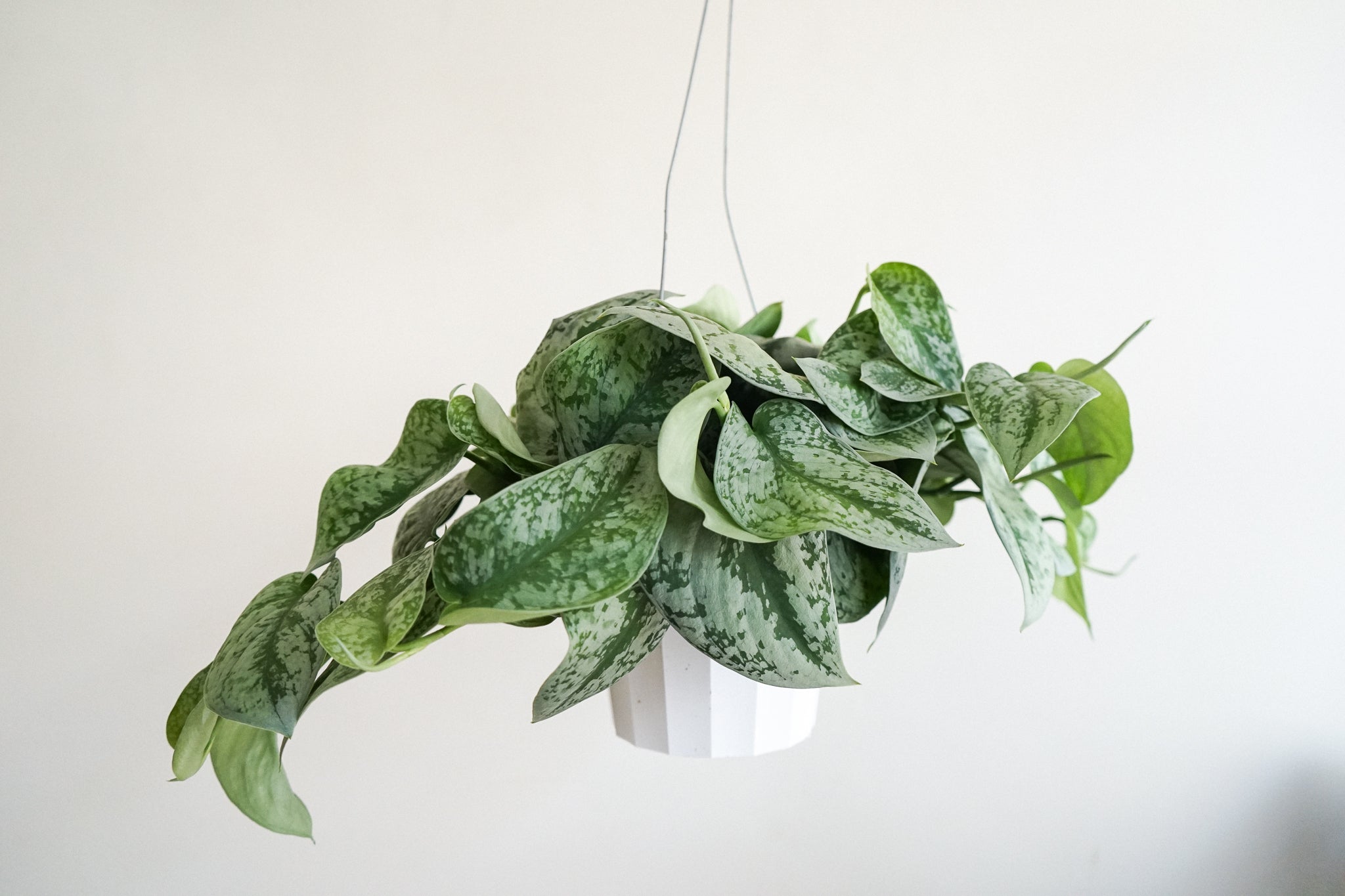
- Unique Appearance:
- Features a blend of green and silver-white splashes on its leaves.
- Creates a visually appealing contrast.
- Heart-shaped leaves add natural beauty to any room.
- Cascading Growth Habit:
- Silver Splash Pothos grows in a trailing manner, making it ideal for hanging baskets or elevated surfaces.
- Its cascading vines add elegance to indoor spaces.
- Propagation:
- Method: Propagate through stem cuttings.
- Steps:
- Snip a section of the plant’s vine just below a node.
- Place the cutting in water or well-draining soil.
- Provide bright, indirect light.
- Maintain a consistently moist environment until roots develop.
With proper care and patience, you can enjoy new Silver Splash Pothos plants from your own propagated cuttings.
How to Choose the Right Pothos Variety for Your Collection
Pothos plants are incredibly versatile and come in a wide range of varieties, each with its own unique characteristics. When choosing the right Pothos variety for your collection, there are several factors to consider.
- Aesthetic Preference:
- Decide on the overall look you want to achieve.
- Consider lush green leaves for a traditional feel or vibrant variegation (like golden or neon Pothos) for a more eye-catching appearance.
- Assess your personal style and the theme of your space.
- Lighting Conditions:
- Pothos tolerate lower light levels but thrive better in brighter settings.
- Marble Queen Pothos prefers brighter indirect light.
- Silver Satin Pothos can handle lower light conditions.
- Evaluate the natural light available in your space.
By balancing aesthetics and lighting needs, you’ll find the perfect Pothos variety for your collection! Stay tuned for the next section, where we will dive into tips on proper care and maintenance to keep your Pothos plants thriving.
Tips for Proper Care and Maintenance of Pothos Plants
To ensure the proper care and maintenance of your Pothos plants, there are a few key tips to keep in mind. Firstly, it is crucial to provide them with the right amount of light. Pothos plants thrive in bright, indirect light, but can also tolerate lower light conditions. However, avoid placing them in direct sunlight as it can scorch their leaves.
Watering
Watering is another important aspect of Pothos plant care. It’s best to water thoroughly once the top inch of soil feels dry to the touch. Overwatering can lead to root rot, so make sure the soil is well-drained and avoid letting the plant sit in standing water. Additionally, Pothos plants appreciate moderate humidity levels but can tolerate drier air. Misting the leaves occasionally or placing a tray of water nearby can help increase humidity if needed.
fertilizing
When it comes to fertilizing, Pothos plants are relatively low-maintenance. A balanced, water-soluble fertilizer can be applied every month during the growing season (spring and summer) to promote healthy growth. However, avoid overfertilizing as it can lead to excessive leaf growth and a weak root system.
pruning
Lastly, regular pruning is essential to maintain the shape and health of your Pothos plant. Trim back leggy or yellowing vines to encourage new growth and remove any dead or damaged leaves to prevent pests and diseases.
The following tables explain few tips for proper care and maintenance of pothos plants:
| Care Aspect | Frequency/Interval | Quantity/Amount | Notes |
|---|---|---|---|
| 1. Watering | Once a week | 1 cup per plant | Keep soil consistently moist but not waterlogged. |
| 2. Light Exposure | Indirect sunlight | 6-8 hours daily | Pothos thrives in moderate to bright, indirect light. |
| 3. Fertilization | Monthly | Balanced liquid fertilizer | Use a diluted, balanced fertilizer during the growing season. |
| 4. Pruning | Every 2-3 months | As needed | Trim yellow or damaged leaves to encourage new growth. |
| 5. Soil Type | Well-draining potting mix | – | Use a mix with good aeration and drainage properties. |
| 6. Temperature | 65-75°F (18-24°C) | – | Maintain a consistent room temperature for optimal growth. |
| 7. Humidity | Moderate humidity | – | Pothos adapts well to average indoor humidity levels. |
| 8. Pest Control | Monthly inspection | Neem oil or insecticidal soap | Check for pests and treat promptly if detected. |
By following these tips, your Pothos plants are likely to flourish and become a beautiful addition to your indoor garden.
Common Issues and Troubleshooting for Pothos Plants
Pothos plants are generally easy to care for and are known for their resilience. However, like any other houseplant, they can encounter a few common issues.
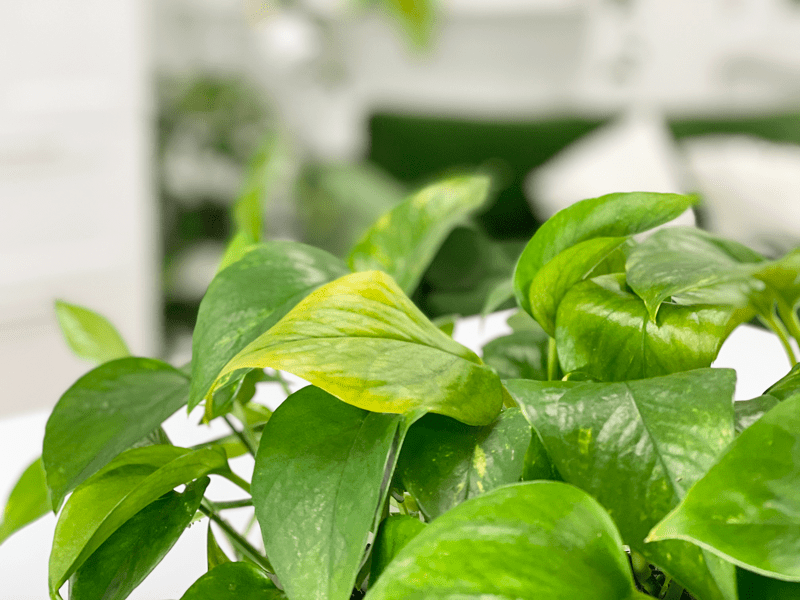
- Yellowing Leaves:
- Cause: Yellowing leaves can result from overwatering or underwatering.
- Solution:
- Water consistently, allowing the top inch of soil to dry out between waterings.
- Avoid direct sunlight, as it can also lead to leaf yellowing.
- Root Rot:
- Cause: Root rot occurs when roots sit in water for too long, leading to decay.
- Prevention:
- Use well-draining soil and a pot with drainage holes.
- Allow excess water to drain away after watering.
- If you detect signs of root rot (foul smell, mushy roots), promptly repot the plant in fresh, well-draining soil, trimming damaged roots.
Remember these tips to maintain healthy and thriving pothos plants! 🌿
Expert Advice and Recommendations for Growing Pothos Successfully
When it comes to growing pothos successfully, there are a few expert advice and recommendations to keep in mind.
- Variety Selection:
- Choose the right pothos variety based on your preferences and available space.
- Each type has unique leaf patterns and growth habits.
- Consider lighting conditions, temperature, and available space before deciding.
- Popular varieties include Neon Pothos and Marble Queen Pothos.
- Proper Care and Maintenance:
- Lighting: Pothos prefer bright indirect light but can tolerate lower light conditions.
- Watering: Keep the soil consistently moist but not waterlogged.
- Overwatering leads to root rot.
- Underwatering causes leaf wilting.
Checking the moisture level of the top inch of soil before watering is a good practice. Pruning your pothos plants periodically to control their size and shape is also recommended, as it stimulates growth and helps to maintain a bushy appearance. Following these guidelines will maximize the beauty and longevity of your pothos plants.
Watch video for more information:
fAQ
What are the different varieties of Pothos plants?
The different varieties of Pothos plants include Marble Queen Pothos, Golden Pothos, Neon Pothos, Jade Pothos, N’Joy Pothos, Cebu Blue Pothos, Manjula Pothos, Silver Satin Pothos, Pearls and Jade Pothos, Jessenia Pothos, Glacier Pothos, and Silver Splash Pothos.
How do I choose the right Pothos variety for my collection?
When choosing a Pothos variety for your collection, consider factors such as the lighting conditions in your space, the desired aesthetic, and the level of care required for each variety. Some varieties may thrive in low light conditions, while others may require brighter indirect light.
What are some tips for proper care and maintenance of Pothos plants?
To properly care for and maintain Pothos plants, make sure to place them in a well-draining pot with good quality potting soil. Water the plants when the top inch of soil feels dry and avoid overwatering. Provide them with indirect sunlight or bright, filtered light. Regularly trim and prune the plants to promote bushier growth. Fertilize the plants every 2-4 weeks during the growing season.
What are some common issues and troubleshooting tips for Pothos plants?
Some common issues with Pothos plants include yellowing leaves, root rot, pests, and lack of growth. Yellowing leaves may be a sign of overwatering or insufficient light. To address this, adjust your watering schedule and move the plant to a brighter location. Root rot can be avoided by ensuring proper drainage and avoiding overwatering. Pests such as spider mites and mealybugs can be treated with insecticidal soap or neem oil. Lack of growth may indicate a need for more light or nutrients, so consider adjusting the plant’s location or fertilizing more frequently.
What are some expert advice and recommendations for successfully growing Pothos plants?
Experts recommend providing Pothos plants with bright, indirect light and allowing the soil to dry somewhat between waterings. They also suggest using a well-draining potting mix and regularly pruning the plants to promote bushier growth. Additionally, experts advise fertilizing the plants regularly during the growing season and keeping an eye out for any signs of pests or diseases.

Studied Agricultural Engineering-Plant Protection at University of California, Davis.
Head of Content writing team at Southelmontehydroponics.com

